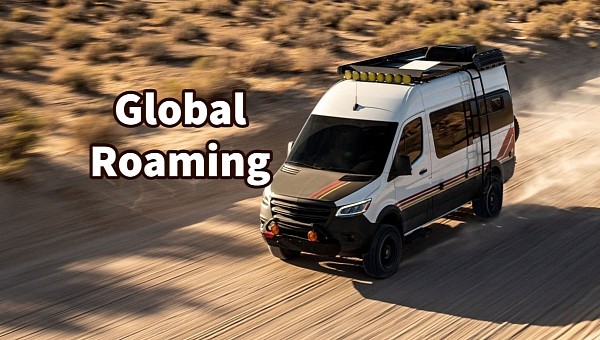SpaceX launched the Starlink for RVs last summer with great success. Since then, Starlink's internet service has expanded in other segments with Maritime and Aviation plans. SpaceX has given Starlink for RVs a twist, rebranding it into Starlink Roam.
People felt liberated when SpaceX launched Starlink for RVs. The service was not exclusive to RVs, as it could be used almost everywhere and for everything, from remote cabins in the mountains to boats near land. The service was so good that many bought it instead of the more expensive Maritime plan. Although SpaceX doesn't recommend using the service on moving vehicles, Starlink for RVs has worked without issues in these conditions.
Almost a year after the service launched, SpaceX acknowledged that people used it less for RVs and more for other scenarios. We guess that's why it rebranded the service as Starlink Roam, emphasizing its most important feature. It also added a global roaming feature for people who frequently jump from one continent to another, although they have to cough up more money, $200 per month. For those that do not cross the continent boundaries on a regular basis, the basic Roam plan is ok, at $150 per month. This is still $15 more than the Starlink for RVs cost before.
Of course, global roaming or not, users still need to carry the cumbersome satellite dish wherever they need to connect. Regardless of the plan, they could opt for either the Portable kit for $599 or the Mobile kit comprising a High-Performance antenna for $2,500. The latter is the only one SpaceX recommends for use on moving vehicles, so choose wisely. Although the Portable kit works on moving vehicles, you risk voiding the warranty. The antenna features positioning motors that might get overloaded while in motion. The Mobile antenna does not have moving parts.
Starlink Roam is still subject to limitations compared to the Residential plan. SpaceX caps the connection to a maximum of 50 Mbps, half the speed of residential users. Roam users also don't have priority access, meaning they get whatever bandwidth is left after priority users are taken care of. On the plus side, Roam users can connect even in areas without ground stations, although latency can get quite high in these regions.
Since SpaceX has not published a list of areas where global roaming can be used, it's safe to assume that the service can be used in all regions where Starlink is active. The regional Starlink Roam plan is geo-fenced to work on land within the same continent as the registered shipping address. The global option, on the other hand, works on land anywhere there is active service coverage. I wouldn't hold my breath about it working at sea except in areas close to the shore.
Almost a year after the service launched, SpaceX acknowledged that people used it less for RVs and more for other scenarios. We guess that's why it rebranded the service as Starlink Roam, emphasizing its most important feature. It also added a global roaming feature for people who frequently jump from one continent to another, although they have to cough up more money, $200 per month. For those that do not cross the continent boundaries on a regular basis, the basic Roam plan is ok, at $150 per month. This is still $15 more than the Starlink for RVs cost before.
Of course, global roaming or not, users still need to carry the cumbersome satellite dish wherever they need to connect. Regardless of the plan, they could opt for either the Portable kit for $599 or the Mobile kit comprising a High-Performance antenna for $2,500. The latter is the only one SpaceX recommends for use on moving vehicles, so choose wisely. Although the Portable kit works on moving vehicles, you risk voiding the warranty. The antenna features positioning motors that might get overloaded while in motion. The Mobile antenna does not have moving parts.
Starlink Roam is still subject to limitations compared to the Residential plan. SpaceX caps the connection to a maximum of 50 Mbps, half the speed of residential users. Roam users also don't have priority access, meaning they get whatever bandwidth is left after priority users are taken care of. On the plus side, Roam users can connect even in areas without ground stations, although latency can get quite high in these regions.
Since SpaceX has not published a list of areas where global roaming can be used, it's safe to assume that the service can be used in all regions where Starlink is active. The regional Starlink Roam plan is geo-fenced to work on land within the same continent as the registered shipping address. The global option, on the other hand, works on land anywhere there is active service coverage. I wouldn't hold my breath about it working at sea except in areas close to the shore.






